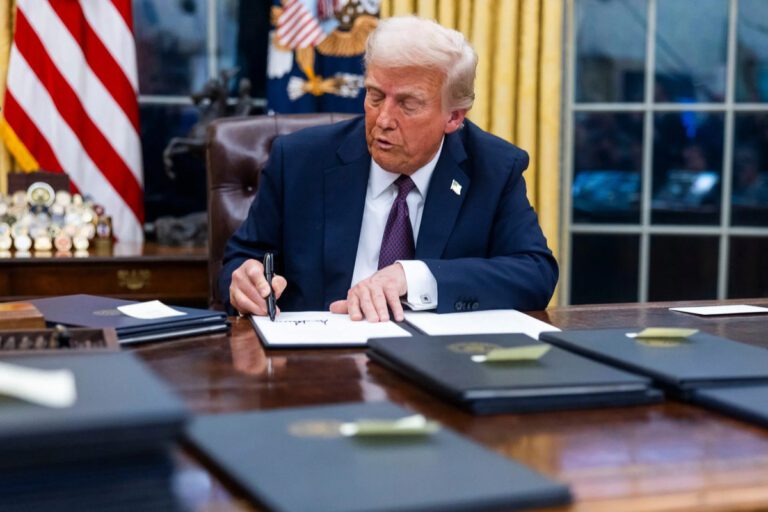🎧 Listen to This Article
The countdown to a potentially seismic summer in global economic policy has begun.
Over the next 90 days, the Trump administration is juggling three explosive issues—a revival of aggressive tariffs, a sweeping tax reform bill, and a ticking debt ceiling deadline—in what analysts are calling a “triple collision course” that could redefine market stability and global trade dynamics for years to come.
Individually, each of these would be significant. Taken together, they represent the most volatile intersection of U.S. fiscal and trade policy since the 2008 financial crisis.
“We’re going to get surprised over and over again in the next 90 days,” said Harvard economist Jason Furman. “The only question is whether those surprises are happy or not.”
The Tariff Timeline: July 9 as Ground Zero
President Trump’s decision this month to impose a 90-day pause on new reciprocal tariffs—while exempting key electronics like semiconductors, smartphones, and computers—was met with cautious relief in global markets. But Commerce Secretary Howard Lutnick swiftly cooled optimism, warning that those sectors will face tariffs again “in a month or two.”
The exemption, set to expire at precisely 12:01 a.m. on July 9, is less a retreat than a deferral. Behind closed doors, U.S. negotiators are scrambling to ink dozens of trade mini-deals before that deadline. But such deals take time, and many close observers doubt they can be finalized in a matter of weeks.
“With Vietnam and Japan, maybe,” said Rob Casey of Signum Global Advisors. “With the EU? It’s a diplomatic minefield.”
Meanwhile, China has retaliated with 125% duties of its own. Investors are bracing for additional non-economic retaliation from Beijing, as pressure builds on Chinese President Xi Jinping to respond beyond tit-for-tat tariffs.
The semiconductor sector, already reeling from disrupted supply chains and export restrictions, now faces renewed instability.
Tax Cuts and Political Headwinds
Trump’s tax ambitions are similarly audacious: he wants to pass what he calls “one big beautiful bill” to overhaul the tax code before the end of summer.
Last week, the House narrowly passed a budget resolution aligned with the Senate’s version—a necessary step to unlock the reconciliation process, which allows legislation to pass the Senate with a simple majority.
But beneath the procedural progress lies deep division. Republicans are split on critical issues, including:
- Cuts to Medicaid to fund the package,
- Restoring or restricting SALT deductions,
- Tax rates for billionaires, and
- How to account for future deficits using the “current policy baseline.”
The tension is real. House Speaker Mike Johnson can only afford to lose a handful of votes, and even this early win came after intense backroom negotiations.
“These are not Braveheart types looking to take an axe to everything,” said Terry Haines of Pangaea Policy. “Eventually, they may fold, but not without drama.”
Despite promises of growth-boosting reforms, the bill could result in trillions in new red ink, especially if deficit offsets fail to materialize. That possibility is already raising eyebrows among rating agencies and foreign investors.
The Debt Ceiling Wild Card
The U.S. debt ceiling—long a political powder keg—is now being rolled into the same reconciliation bill. That means failure to pass the tax bill could also mean failure to raise the debt ceiling.
The “X Date,” when the U.S. exhausts its borrowing authority, is projected to fall between mid-July and early October, according to the Bipartisan Policy Center.
Here’s where it gets risky: Under reconciliation rules, Congress must specify a dollar amount for the new debt ceiling—no simple suspension allowed. To meet spending needs through the 2026 election, Treasury Secretary Scott Bessent may need to push for a $4–5 trillion increase.
“That’s a political grenade,” said one senior GOP aide. “And some of our members are proudly wearing ‘never voted for a ceiling increase’ like a badge of honor.”
Markets have learned to live with a certain level of Washington brinksmanship. But this time, all three flashpoints—trade, tax, and treasury—are lighting up at once. And the outcomes are far from certain.
Global Stakes: A View from Abroad
Internationally, the stakes are immense.
- Europe is already facing pressure from stalled U.S.-EU trade talks. The threat of sectoral tariffs on German and Dutch electronics could spark new tensions in transatlantic relations.
- Asia—particularly South Korea, Taiwan, and China—will be directly hit by renewed tech tariffs, disrupting supply chains and slowing growth in semiconductor-heavy economies.
- Developing nations could see capital flight if U.S. borrowing spikes and yields rise, weakening currencies and worsening debt burdens.
“A U.S. debt ceiling standoff combined with tariffs is the perfect storm,” said Anika Rao, global strategist at Standard Chartered. “Even countries not directly targeted will feel the tremors.”
Looking Ahead: What Needs to Happen
For the U.S., the smart move would be to decouple the debt ceiling from tax reform. Doing so may be politically awkward—but would offer a cleaner, more assured path to market stability.
For businesses, now is the time to audit tariff exposure, review supply chain alternatives, and prepare for volatility through hedging and financial risk tools.
For foreign governments, building strategic alliances and regional trade agreements will be crucial. The unpredictability of U.S. policy means self-reliance and diversification are no longer optional—they’re essential.
A Summer Like No Other
This summer is not just a political theater—it’s a potential turning point in the global economic order.
If Trump succeeds, he will reshape U.S. fiscal and trade policy for years. If he fails—or fumbles even one component—the resulting chaos could ripple from Wall Street to Shanghai, from Brussels to Buenos Aires.
The only certainty, as one seasoned D.C. lobbyist put it: “Nothing will go as planned.”
For further details, clarification, contributions, or any concerns regarding this article, please contact us at editorial@tax.news. We value your feedback and are committed to providing accurate and timely information. Please note that our privacy policy will handle all inquiries



